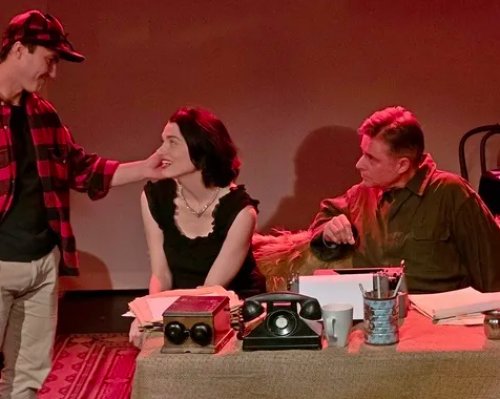
By: Darryl Reilly
People try to understand Jerry. They ask me if I understand what happened. If you want to understand my son’s life, I wouldn’t point you toward “Catcher.” I’d say start with “A Perfect Day for Bananafish.”
A seated actor dressed all in black wearing a beret beats a conga drum on a confined playing area. Other actors in period costumes sit at small cabaret tables and chairs as thick wafts of smoke envelop the stage. On the back wall is a white screen and from behind it is the shadow of a woman dancing. Such is the arresting 1950’s classic beat coffee house imagery director Joe John Battista conjures up for playwright Claude Solnik’s fascinating fantasia derived from the life of J.D. Salinger (1919-2010), A Life in the Rye.

In addition to this small-scale surrealistic polish, center stage is a large vintage wooden desk strewn with appropriate writer’s props including an old typewriter. In front of it is a configuration of sandbags symbolizing Salinger’s isolation.
Mr. Solnik’s well-researched and imaginatively conceived play about the author of the iconic The Catcher in the Rye is a rich tapestry conveying Salinger’s complex temperament and monumental impact. Characters address the audience, they converse with each other and Salinger narrates. Young Salinger appears in a red plaid hunting cap and shirt as both himself and as Salinger’s alter ego.
Solnik takes us to Manhattan’s Upper West Side where Jerome David Salinger grew up to comically depicted stereotypical Jewish parents.
Oona O’Neill was a teenaged socialite when the 23-year-old Salinger met her on Manhattan’s high society scene. The daughter of Eugene O’Neill, she was the love of Salinger’s life and inspired much of his early writing. Her later marriage to Charles Chaplin was a devastation Salinger never got over and she looms over the play.
During brisk vignettes Solnik spins his artful biographical saga. Salinger’s emerges as a major American writer after finally getting his stories into The New Yorker with William Shawn’s help. His W.W. II service includes D-Day and being at a liberated concentration camp. There are two rocky marriages and the stormy later-life relationship with Joyce Maynard, all while compulsively writing. Stung from criticism of his work in the 1960’s particularly by John Updike, Salinger continues writing but refuses to publish.
Appearing in 1951, The Catcher in the Rye became a best-selling cultural phenomenon. Unnerved by the book’s success and put off by the fanaticism it inspired in unbalanced people, Salinger became reclusive. A Life in the Rye begins with a stylized bit depicting John Lennon being gunned down in 1980 by Mark David Chapman. It’s a striking and sensible place to start. However, Chapman returns near the end and almost derails what had been an absorbing experience. For over ten minutes we get stilted and didactic confrontational dialogue between Salinger and Chapman, though it then soon concludes gracefully.
Mr. Battista’s supreme command of stagecraft infuses the production with vitality, momentum and visual accomplishment. Battista’s large cast, several of whom portray multiple roles is uniformly compelling.
Wearing an olive canvas jumpsuit, Tom Martin combines serenity and volatility as Salinger. With his smooth clipped vocal tones and calm presence Mr. Martin is the show’s mesmerizing centerpiece as he forges on through the temporal and emotional journey. Veering from exhibiting adolescent angst to mature solidity, the charismatic Willem Long is a terrific foil and compadre for Martin as Young Salinger. Mr. Long’s youthful animation and soulfulness are ideal.
The alluring, willowy and radiant Janel Koloski makes a great impression as Oona O’Neill. Tony Del Bono and Thami Moscovici are each hilarious yet thoughtful as Salinger’s parents. Chris Johnson’s astonishing quick change gallery of celebrated literati includes Ernest Hemingway, William Shawn, Robert Giroux, Whit Burnett and even more, all rendered with distinction and precision. Employing a wavery speech and a exhibiting a haunted countenance, Harry Bainbridge is suitably eerie as Mark David Chapman. Annalisa Plumb, Alexandra Laliberte, Olivia Osol and Vilma Hodo all offer strong turns as the various other women in Salinger’s life.
Allison Hohman’s lighting and sound design are both equally atmospheric, contributing to a dreamy dimension. Costume designer Wendy Tonken evokes the glamour and spirit of past eras with her commanding assortment of varied garments.
Crackling with theatricality, A Life in the Rye is an enticing portrait of that legendary artist.
I’ve always tried to find some kind of purity, honesty, in the world. This is the only way to write completely honestly. Why do writers write? To create and preserve people, experiences, language.
A Life in the Rye (through November 24, 2019)
Theater for the New City, 155 First Ave, in Manhattan
For tickets, call 212-254-1109 or visit http://www.theaterforthenewcity.net
Running time: 100 minutes without an intermission
